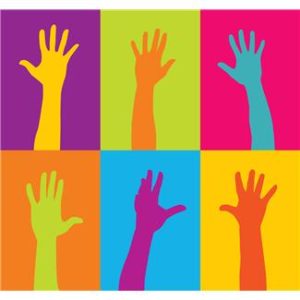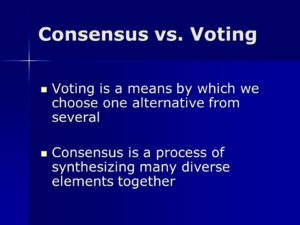Taking decisions – misunderstandings about voting
 Continuing our series of posts about decision-making, we’re starting to explore here the relationship between consensus decision‑making and voting, and when to use different methods. Let us know about your experiences of decision‑making in practice, citizen’s assemblies and other topics touched on in this blog.
Continuing our series of posts about decision-making, we’re starting to explore here the relationship between consensus decision‑making and voting, and when to use different methods. Let us know about your experiences of decision‑making in practice, citizen’s assemblies and other topics touched on in this blog.
There are resources available to help you in your decision‑making, on facilitation, on consensus decision‑making, and a plethora of our older resources here for even more tips and tricks.
If you’re a bit stuck, are facing a particularly difficult decision, or would just like an external facilitator to support your decision‑making and group‑work, get in touch.
Read more about our facilitation services, and other help we can give you.
There are two enormous misunderstandings about voting, both contained in a single sentence from a ‘Consensus Handbook’ published by the generally admirable coop, Seeds for Change. The sentence states that, “When you vote, any idea which most people like will be accepted, and the concerns of the people who opposed it can be ignored.”
The first error is the belief that the vote decides the issue. This is indeed one definition of a vote, that it is “the decision reached by voting”, as in “people voted for Brexit.” But a more accurate definition of voting is: “a formal indication of a choice between two or more candidates or courses of action, expressed typically through a ballot or a show of hands.” By this definition, a vote establishes the balance of opinion. Whether that balance is decisive or not is a separate question. It can simply be indicative, a guide for further discussion.
I can illustrate this using a day I helped at in Manchester in June 2017 for ‘Jam and Justice’, a project to use devolution to try out new ways to govern cities. 17 proposals had been compiled in advance. On the day, ten of them were selected, by a vote. The initial sense was simply to run with these ten. But discussion led to a series of proposals, of increasing sophistication. The sixth and final proposal, which commanded everyone’s assent, was to: have two projects in reserve; test how the ten projects worked as a set; and replace one or two by reserves if that made for a better set.
The second error lies in thinking that a vote will always produce a majority and a minority. Preference voting, where people put options in order of preference, is one example of voting that doesn’t do that.
 The consequence of these errors is that the enormous advantages of voting are ignored. It’s quick – you can imagine how long it could have taken for fifteen people to choose the ten Jam and Justice projects had it been by talk alone. It is often anonymous, avoiding the terror that many people have of speaking in public. The great drawback of voting, though, is its clumsiness. It reveals nothing about the reasons for the way someone voted, or what would have made them vote differently. In its usual form, where each person has a single vote to case, no information is revealed about how strong was their preference for the person or cause they voted for, nor about their views on the other options on the ballot paper.
The consequence of these errors is that the enormous advantages of voting are ignored. It’s quick – you can imagine how long it could have taken for fifteen people to choose the ten Jam and Justice projects had it been by talk alone. It is often anonymous, avoiding the terror that many people have of speaking in public. The great drawback of voting, though, is its clumsiness. It reveals nothing about the reasons for the way someone voted, or what would have made them vote differently. In its usual form, where each person has a single vote to case, no information is revealed about how strong was their preference for the person or cause they voted for, nor about their views on the other options on the ballot paper.
Put that way, it is evident that good decision-making depends on finding the right balance, given the situation, between talking and voting.

